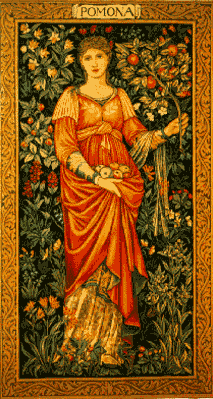
Halloween's origins date back to the ancient Celtic festival of Samhain (pronounced sow-in). The Celts celebrated their new year on November 1, to mark the end of summer and harvest and the beginning of winter.

According to my Irish grandmother,
they believed that on the night before the new year, the boundary between the worlds of the living and the dead became blurred. Otherworldly spirits who came to visit would
cause trouble and damage crops, but their presence also helped the Druids, the Celtic priests, to make predictions about the future. Since their people were entirely dependent on the volatile natural world, these prophecies were an important source of comfort and direction during the long, dark winter.

All hearth fires were extinguished and the Druids built huge sacred bonfires, where the people, in costumes gathered to burn crops and animals as sacrifices to the Celtic deities. They also
attempted to tell each others fortunes. When the celebration was over, they re-lit their hearth fires, which they had extinguished earlier that evening, from the sacred bonfire to help protect them during the coming winter.

Through the years (400) that the Romans ruled Celtic lands, a couple of their festivals were thrown into the mix:
Feralia, when the Romans traditionally commemorated the passing of the dead, and a day to honor
Pomona, the Roman goddess of fruit and trees. The symbol of
Pomona is the apple and the incorporation of this celebration into Samhain may explain the tradition of "bobbing" for apples that is practiced today on Halloween.

When Christianity hit Celtic lands, it too left its mark on the 'holiday.' In the seventh century, Pope Boniface IV designated November 1 All Saints' Day, probably in an attemp to replace the Celtic festival of the dead with a related, but church-sanctioned holiday. The celebration was also called All-hallows and the night before it, the night of Samhain, began to be called All-hallows Eve and, eventually, Halloween.
Later, the church made November 2 All Souls' Day, a day to honor the dead. Its celebration was similar to Samhain, with big bonfires, parades, and dressing up in costumes as saints, angels, and devils.
Together, the three celebrations, the eve of All Saints', All Saints', and All Souls', were called Hallowmas.
(Illus #2 - Spirit Raising Samhain
© Rich CrystalWolfe Baker)

 According to my Irish grandmother,
According to my Irish grandmother, All hearth fires were extinguished and the Druids built huge sacred bonfires, where the people, in costumes gathered to burn crops and animals as sacrifices to the Celtic deities. They also
All hearth fires were extinguished and the Druids built huge sacred bonfires, where the people, in costumes gathered to burn crops and animals as sacrifices to the Celtic deities. They also Through the years (400) that the Romans ruled Celtic lands, a couple of their festivals were thrown into the mix:
Through the years (400) that the Romans ruled Celtic lands, a couple of their festivals were thrown into the mix:


No comments:
Post a Comment